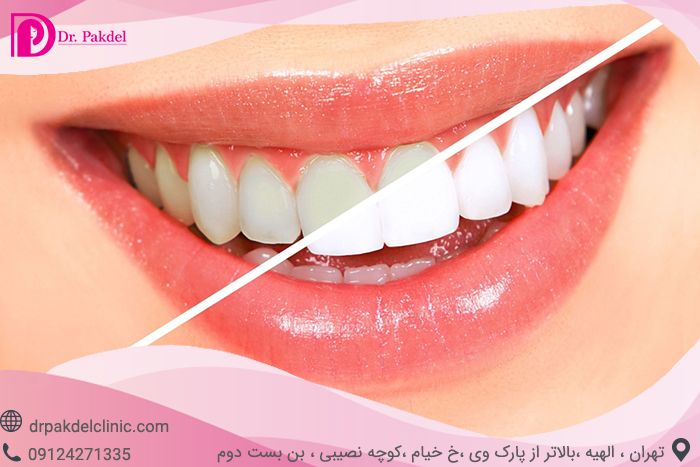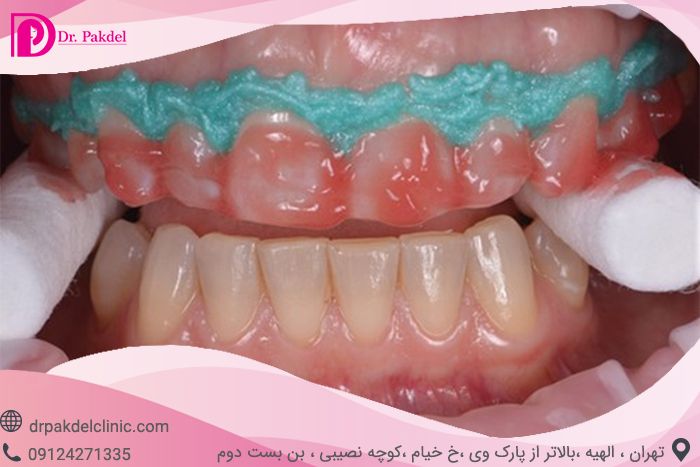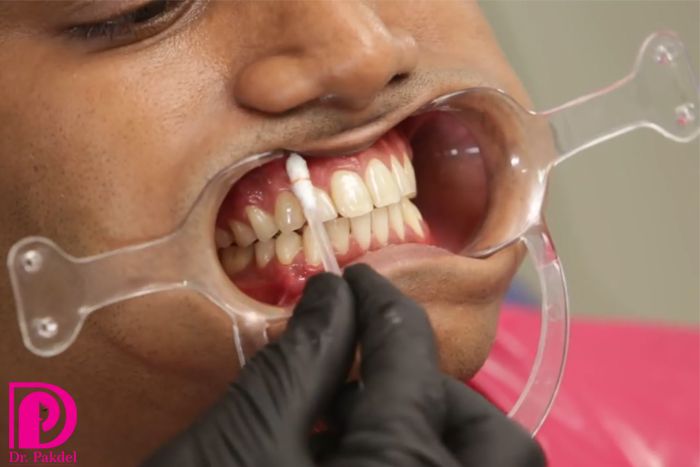Abstract of this article: What is tooth bleaching? Cause of black or dull teeth. How is tooth bleaching done? The difference between laser bleaching and conventional bleaching. Care after bleaching. Disadvantages and complications of dental bleaching. Comparison of teeth bleaching in the office and at home. Steps to use bleaching at home. Benefits of Teeth Bleaching. Is teeth whitening with tooth bleaching technique permanent? … For free dental consultation, you can call the following numbers: 09124271335, 02122018323, 02122024362, 02122026495
?When should tooth root canal be performed
?What is tooth scaling and how is it done

Tooth bleaching:
With the advancement of modern medicine and dentistry, beauty is no longer a dream. Perhaps in the past, many embarrassed yellow teeth avoided laughing, and having white, beautiful and shiny teeth was nothing more than a dream, but today, with the advancement of technology, a A beautiful smile is easily accessible to everyone. The natural color of teeth can be yellow and dull, orange, gray or even blue or green and lose their beauty. Unpleasant appearance of teeth will lead to consequences such as loss of self-confidence. One of the ways to whiten teeth and one of the good dental techniques in teeth
whitening is bleaching. They are used together.
What is tooth bleaching?
Bleaching is one of the teeth whitening techniques during which nothing is added or subtracted to the tooth structure, so the tooth structure will not be damaged. In this method, the main tooth itself is treated, which only uses white tooth materials. Tooth whitening materials contain peroxide, which removes deep and superficial stains on the teeth and makes the teeth even brighter than their natural color. This substance can whiten and brighten the teeth by penetrating the enamel. Tooth bleaching can be done with two techniques, one in dental offices and the other at home. However, in the office, it can be done in two ways, one with laser and the other without laser. We will explain in full.
Tooth recognition:
Before you do teeth bleaching, it is better to know the structure of the tooth to have a better understanding of the cosmetic procedures of the teeth.
Teeth: Each tooth consists of two parts, the crown and the root. The crown is located at the top of the gums and is actually the visible part of the tooth. This part is covered with enamel. And the root is the invisible part of the tooth that is located in the gum tissue. In the bleaching technique, the visible part of the tooth, ie the crown, will be treated!

Causes of discoloration, dullness and damage to teeth:
smoking
Consumption of colored drinks such as tea and coffee and sugary foods
Unhealthy diet
Lack of oral hygiene: Do not brush your teeth, do not floss
Damage to the enamel
Taking antibiotics such as tetracycline or high levels of fluoride when teeth are growing
Tooth decay due to filling with silver material
Loss of natural tooth enamel due to aging
How is tooth bleaching done?
When it comes to teeth bleaching, you have two options: Office Bleaching and Home Bleaching!
Both methods of tooth bleaching use peroxide. Bleaching Home uses 3 to 20% peroxide, which varies depending on the method, and 15 to 45% peroxide in Bleaching Office!
The higher the peroxide content, the less time it takes to stay on the teeth, but if this time exceeds the allowable limit, it will cause tooth damage and allergies.
Bleaching in the dental office:
Step 1: Before making any decision, it is best to have a consultation with the dentist to examine the teeth and determine if this technique is right for you or not! Also ask your dentist about the methods of teeth whitening, its results and durability, as well as whether it will have any side effects for you, for example, whether it will cause gingival allergies or.. It is recommended to know the costs before doing this technique!
Before undergoing cosmetic surgery, it is best to treat your teeth first and then go for cosmetic procedures. Your doctor may ask you to bleach your teeth after dramatically reducing the number of times you smoke, so that you do not waste time and money.

Step 2: Once you have determined that teeth whitening is right for you, it is time for your teeth whitening session. Tooth color has different ranges, first the color of the patient's teeth is determined and then it is determined how many degrees the tooth should be whitened. To do this, the mouth is opened with a dental mouthwash, and then the soft tissues of the mouth, cheeks, and gums are protected by a special protector rather than gels for the gums and other areas. Do not touch the mouth, then the dentist moves slowly and tooth to tooth and impregnates the teeth with a special gel, after which time is given to stop the chemical activity of the bleach. The concentration of the gel varies depending on the need for teeth whitening.
Step 3: In the next step, the gel is cleaned and then it is the turn of after bleaching gel that stays on the teeth for about two minutes. The use of this gel is used to reduce the sensitivity of the teeth and the teeth bleaching is done. .
This procedure takes about an hour, when the dentist uses a teeth whitening gel containing hydrogen peroxide on the teeth, then targets the teeth with a special heat lamp at three intervals of twenty minutes.
Bleaching in the office is done in two ways, the other method is using a laser.
Laser bleaching in the office: This technique is another method of tooth bleaching. This method is not much different from the previous method. The only difference is that after applying the gel, laser beams are used to activate the reaction of the material by shining the rays. But there are differences in benefits. In the laser method, scaling of the teeth is done first to clean the teeth from contamination, then protective glasses are used to protect the eyes during bleaching. Also, a plastic protector will be used to protect the gums. Laser tooth bleaching is usually hydrogen peroxide because it gives better results.
Differences between laser bleaching and conventional bleaching:
In laser bleaching of teeth, the degree of whitening will be higher because the penetration depth of the laser is greater.
Laser time is shorter: with a laser, you will definitely see an immediate result. Also, a 30- or 60-minute bleaching session will be reduced to about 10 minutes.
Less damage to the teeth due to the need for less repetition and longer durability of this procedure.
Uniform radiation of light to the teeth
Bleaching care:
It may not require strict care, but it is recommended that you take some care.
It is best to watch your diet for 48 to 72 hours after bleaching your teeth.
Do not eat very cold and very hot foods.
It is recommended to avoid colored foods such as ketchup sauce and foods containing tomato paste, tomatoes, saffron, turmeric and vegetables during this time.
Avoid drinking tea, coffee and Nescafe during the said time after bleaching.
Be sure to brush and floss after eating, as good oral hygiene is the most important care option.
It is better to use anti-allergy toothpaste to minimize tooth sensitivity, because in the first few days after teeth bleaching, you will feel a little sensitive, which of course is temporary.
It is recommended to see a dentist about a week after teeth bleaching to check the teeth.
Benefits of teeth whitening:
With tooth bleaching technique, you will see teeth that are white, shiny and free from contamination.
No need to cut teeth
painless
The speed of this method
Affordable compared to other techniques
With a more beautiful smile, you will experience higher self-confidence.
No damage to teeth
An easy procedure that does not require anesthesia, anesthesia, rest and serious care.
Tooth bleaching is a compensatory method, which means that if the teeth become discolored again, they can be easily whitened.
Bleaching at home:
Method 1:
If you need this treatment, you should see a dentist first, and if your tooth needs treatment, treatment should be done first. The steps of teeth bleaching at home are as follows:
Step 1: First, the teeth are scaled in the office, then a mold will be prepared from your teeth by the dentist.
Step 2: Based on the prepared template, functional trays are made. Simply put, it is a toothpaste filled with bleaching agents.
Step 3: After the person is given the necessary equipment, he will be taught how to use the bleaching gel at home. The patient should use this guard and gel for about 1 to sometimes even 4 weeks to complete the bleaching period. About one to four hours according to the dentist's instructions. Some gels have the ability to use a shorter treatment.
Method 2:
Use of tooth bleaching strips and gels; This should be done once or twice a day by applying strips or brushes impregnated with bleaching gel to the teeth. It takes about 10 to 15 days and the results can last between 4 months or more. . Strips sometimes cause tooth sensitivity and burning gums. See your dentist if you have this side effect.
Strips are generally less effective than custom trays because saliva can seep under the strips and dilute the bleach. The strips may not be wide enough and often slip out of place, although most bleach strips are considered safe because they have low peroxide strength. However, be careful not to use strips containing chlorine dioxide that can Avoid damaging the enamel.
Steps to use bleaching at home:
First, oral hygiene must be fully observed, and before bleaching, the teeth must be brushed and flossed between our teeth.
Then follow the dentist's instructions and carefully place the tray containing the gel on the tooth. If the gel comes out, clean it.
The risk of teeth whitening at home and using home teeth whitening kits: Some teeth whitening kits do not have enough material to whiten teeth so they can not affect the teeth. Also, if this is not done by a dental professional, it is possible The mold does not fit the individual's teeth, and when using some tooth bleaching agent, it affects the gums and causes allergies.
Comparison of teeth bleaching in the office and at home:
Be sure to consult your dentist for teeth whitening at home as this may not be right for you.
Teeth whitening by a dentist and in the office will definitely have a better and different result.
Office bleaching is usually more powerful than home bleaching because in office, temperature, light, or a combination of both are used for better productivity.
Frequently Asked Questions :
Who should do teeth bleaching?
Teeth whitening is a cosmetic dental job and should be done by a specialist in this field. Some beauty salons do this, but it is illegal and can endanger oral health. Of course, there are also home bleaching kits that have different results and may also have risks. .
How do we know that we are getting results from tooth bleaching?
This should be done with the opinion of the dentist, so you should trust the consultation with the dentist. You can also consult with people who have done this before to make sure.
To read the rest of the article and view the services and portfolios, refer to the website of Dr. Pakdel Clinic. Free consultation: 09124271335, 021220118323,02122024362
Dr. Pakdel Clinic Instagram Page Address: drpakdelclinic @
 icons at the top right corner of the subsection.
icons at the top right corner of the subsection.